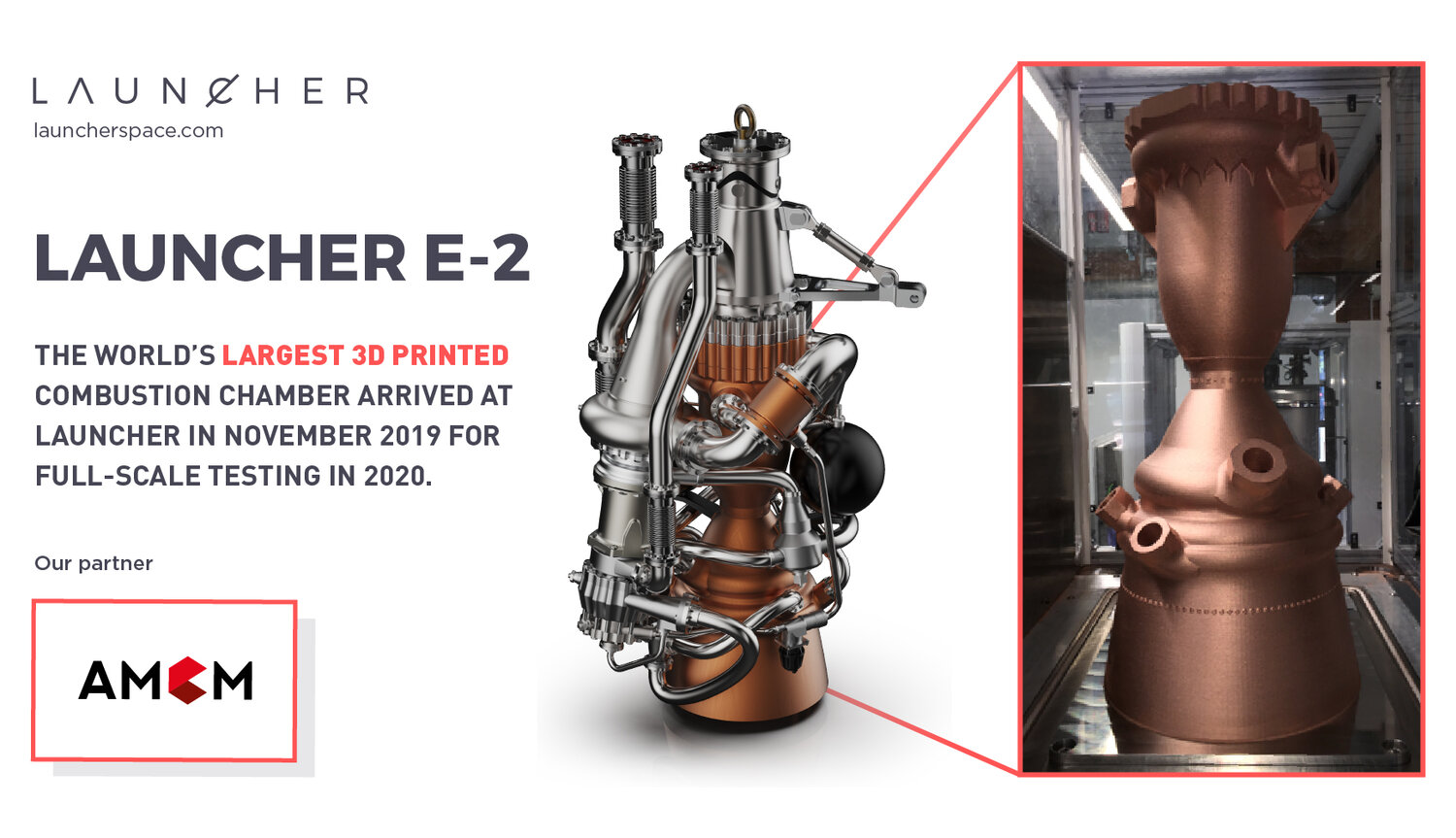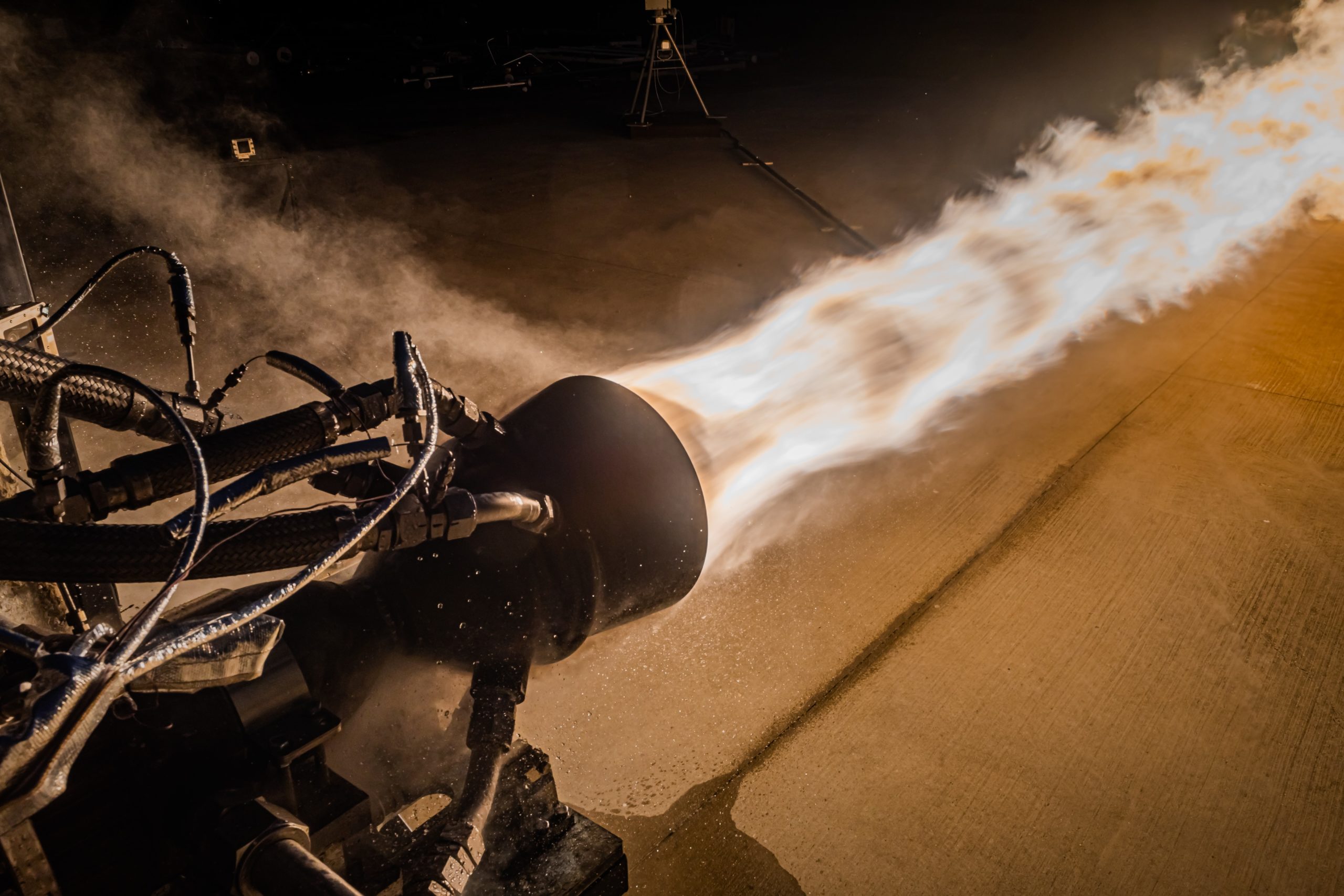Launcher Acquires AMCM M4K Printer to 3D Print Whole Engine Combustors on Site
Back in 2018, the CEO and founder of rocket company Launcher, Max Haot, was looking for a solution to print entire combustion chambers for his rocket engine. The parts are typically very large and have intricate internal regenerative cooling channels, so finding a 3D printing process to produce a large copper alloy, single-part, was difficult but critical for Launcher’s goal towards high performance and low production costs. The company turned to manufacturer Additive Manufacturing Customized Machines (AMCM) to develop an ideal printer for the job. Nine months later, AMCM released its M4K industrial metal 3D printer and printed a first combustion chamber model out of cast aluminum alloy.
Since then, Launcher and AMCM – an EOS Group company – began a long-standing partnership that led to the creation of the world’s largest, single-part 3D printed combustion chamber. Now, the rocket maker announced the purchase of the M4K printer to make combustors at its new Hawthorne, California headquarters and production facility. By additively manufacturing the entire 10 ton-force E-2 rocket engine, Launcher hopes to continue developing its orbital launch vehicle. Once complete, the rocket will be ready to commercially deliver small satellites to low Earth orbit (LEO) by 2026. And since the engines will require less propellant to get to orbit, the company hopes to deliver more satellite cargo per rocket and offer a lower price than its competitors.
In a LinkedIn post announcing the purchase, Haot said that “in 2017, the space industry needed a 3D printing breakthrough to print larger liquid rocket engines. To meet the challenge, we partnered with AMCM GmbH to create the AMCM M 4K 3D printer for printing Launcher’s E-2 liquid rocket engine chamber as a single part in copper alloy.”

Launcher E-2 prototype 3D printed in copper alloy with AMCM 3D platform. Image courtesy of Launcher.
Most companies building 3D printed liquid rocket engines have been forced to design smaller engines or produce multi-part combustion chambers to fit within the limited construction volume constraints of commercial 3D printers, says AMCM. However, Launcher needed to 3D print its E-2 engine combustion chamber as a single part, enabling optimal cooling channel design, fewer parts, simpler processes, and lower overall production costs.
While space companies 3D printing liquid rocket engines rely on Inconel alloy as their combustion chamber material, Launcher turned to NASA research to learn more about 3D printing copper. Then they asked for support from AMCM and EOS to print copper alloy, which offers optimal thermal conductivity properties, enabling more effective regenerative cooling. Thanks to Launcher’s design, the use of 3D printed copper alloy, and a unique liquid oxygen cooling system, the prototype sub-scale engine currently being tested is so efficient (over 98% according to Launcher) that it produces a blue exhaust plume, which is unprecedented for kerosene engines.
AMCM Managing Director Martin Bullemer pinpointed several major advantages of metal AM in producing liquid rocket engines, including lower manufacturing costs and more design flexibility. But printing in a single piece not only reduces costs it also enables the highest-performance regenerative cooling design. Bullemer said the result of these benefits is an improved propulsion system that uses less propellant, carries larger payloads, and enables new ideas and applications to take flight. The expert highlighted: “Additive manufacturing is revolutionizing the space industry, and innovative companies like Launcher are taking advantage of this advanced 3D printing technology.”
Now in serial production at AMCM’s expanded facility in Starnberg, Germany, the customized, high-performance Direct Metal Laser Solidification (DMLS) M4K printers are tailored to produce large applications, with a height up to one meter (40 inches), and capable of printing copper alloy, the most advanced material for liquid rocket engine combustion chamber production.
Built on the EOS M 400 platform, the AMCM M 4K large scale, high productivity system is ideal for demanding AM applications and has up to 400 or 1.000 Watt laser power. Additional features include increased robustness of the frame design, a new filter system, and optional soft recoating. Out-of-the-box, the AMCM M 4K can produce applications from a wide range of materials, not just copper alloy, like aluminum and nickel alloy.
With partner AMCM, Launcher built its first rocket engines in October 2019. Following the test-fire in October 2020 at NASA’s Stennis Space Center in Mississippi as part of a $1.5 million U.S. Air Force award, the company decided it was time to purchase the M4K. The new platform will be part of Launcher’s new 24,000-square-foot building in California, where it will complete its launch vehicle.
Subscribe to Our Email Newsletter
Stay up-to-date on all the latest news from the 3D printing industry and receive information and offers from third party vendors.
Print Services
You May Also Like
3D Printed Propulsion Specialist Ursa Major Sells 10 Hadley Engines to Japanese Space Startup
Ursa Major, the Colorado-based specialist in scaling additive manufacturing (AM) for propulsion solutions, has reached an agreement to sell ten Hadley engines to Sirius Technologies, the US subsidiary of Tokyo’s...
3D Printing Financials: Velo3D Resets After Losses
After a tough 2024, Velo3D (OTC: VLDX) is moving forward with a new strategy. The company, which built its reputation on cutting-edge metal 3D printing, just wrapped up 2024 with...
Japanese Advanced Manufacturing Capabilities Grow in Europe with Sodick’s Purchase of Prima Additive
The global economy is currently undergoing a reshuffling in terms of what gets manufactured where. In large part, this trend is being driven by new geopolitical alliances and the need...
3D Printed Rocket Motor Specialist Ursa Major Lands $15M Satellite Propulsion Contract
Ursa Major, the Colorado-based leader in deploying additive manufacturing (AM) for propulsion solutions, has received a contract from an unnamed customer for geostationary earth orbit (GEO) propulsion systems. The multi-year...




























